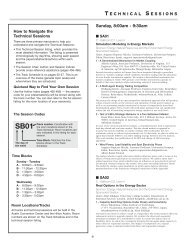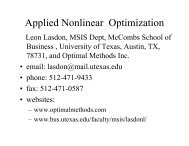Sunday
Sunday
Sunday
You also want an ePaper? Increase the reach of your titles
YUMPU automatically turns print PDFs into web optimized ePapers that Google loves.
SA02<br />
■ SA02<br />
02- West 102 A- CC<br />
Decision Analysis Applications in the Energy Industry<br />
Sponsor: Decision Analysis<br />
Sponsored Session<br />
Chair: Mazen Skaf, Partner & Managing Director, Strategic Decisions<br />
Group, 745 Emerson St, Palo Alto, CA, 94301, United States of<br />
America, MSkaf@sdg.com<br />
1 - A Decision Quality Approach to Natural Gas Resource<br />
Uncertainty<br />
Robert Stibolt, Managing Director, Galway Group, L.P.,<br />
3050 Post Oak Blvd., Suite 1300, Houston, TX, 77056,<br />
United States of America, rstibolt@galwaygroup.com, Mazen Skaf<br />
The shale gas revolution started in North America has completely changed the<br />
dynamic of world natural gas markets. Implications are far-reaching, exciting, but<br />
also highly uncertain. For example, the shape of long-run supply curves depend<br />
on technology, geology, and geopolitics. This paper addresses these questions<br />
within a framework that embraces uncertainty while eschewing the illusion of<br />
precise prediction — a key to developing natural gas strategies that are robust.<br />
2 - Hydrocarbon Resource Allocation Strategy for Industry<br />
Development in an Energy-rich Nation<br />
Mazen Skaf, Partner & Managing Director, Strategic Decisions<br />
Group, 745 Emerson St., Palo Alto, CA, 94301,<br />
United States of America, MSkaf@sdg.com, Thomas Seyller<br />
We present a DA-based process and system for optimizing the allocation of<br />
supplies of a hydrocarbon resource across proposed industrial projects taking into<br />
account: i) uncertainty in future supply and demand, ii) various economic, social,<br />
and environmental value measures, and iii) existing commitments for current<br />
domestic uses and industries. The value-focused approach resulted in a paradigm<br />
shift in the industrial development strategy as well as in the future focus of E&P<br />
activities.<br />
3 - Solar Value Chain Decision Analysis in Oil and Gas Rich<br />
Countries<br />
Thomas Seyller, Sr. Engagement Manager, Strategic Decisions<br />
Group, 745 Emerson St., Palo Alto, CA, 94301,<br />
United States of America, tseyller@sdg.com, Dan Cornew<br />
We will explore how decision analysis can help oil and gas rich countries develop<br />
strategies around solar energy that maximize the total benefit to the nation –<br />
including economic value and costs, social benefits such as job creation, and<br />
environmental impacts. Strategies cover a wide range of possible incentives and<br />
mandates throughout the solar value chain, from manufacturing to deployment.<br />
■ SA03<br />
03- West 102 B- CC<br />
Risk and Uncertainty in Public Policy and Defense<br />
Sponsor: Decision Analysis<br />
Sponsored Session<br />
Chair: Jay Simon, Naval Postgraduate School, Defense Resources<br />
Management Institute, 699 Dyer Rd, Monterey, CA, 93943,<br />
United States of America, jrsimon@nps.edu<br />
1 - Uncertainty Model for Rapid Updating of Target Positions<br />
Eva Regnier, Naval Postgraduate School, 699 Dyer Road,<br />
Monterey, CA, 93943, United States of America,<br />
eregnier@nps.edu, Dashi Singham<br />
In many security contexts, forces must allocate their assets based on incomplete<br />
information about targets’ positions. They frequently receive human intelligence<br />
describing past or future events related to target locations. We present an<br />
uncertainty model that allows for rapid updating, conditioning on past or future<br />
events.<br />
2 - Ranking FDA Risks: The Medical Devices Case<br />
Robin Keller, University of California-Irvine, Irvine, CA,<br />
United States of America, lrkeller@uci.edu, Yitong Wang<br />
This talk focuses on a medical devices case study. Keller served as a decision<br />
analyst on the committee charged with suggesting how the FDA can compare<br />
risks across product categories (foods, cosmetics, drugs, etc.). The NRC book<br />
proposed a multiple objective decision analytic approach to ranking risks: “A Risk-<br />
Characterization Framework for Decision-Making at the Food and Drug<br />
Administration” is at http://dels.nas.edu/Report/Risk-Characterization-<br />
Framework-Decision/13156.<br />
INFORMS Phoenix – 2012<br />
56<br />
3 - Probability Segmenting: Managing Uncertainty in Military Drafts<br />
Jay Simon, Naval Postgraduate School, Defense Resources<br />
Management Institute, 699 Dyer Rd, Monterey, CA, 93943,<br />
United States of America, jrsimon@nps.edu, Jonathan Lipow<br />
When a nation chooses to enact a draft, this presents an interesting decision<br />
problem for those individuals eligible to be drafted: they can take actions which,<br />
at some cost, will reduce the probability of being selected. It is in society’s best<br />
interest to minimize these costly actions. We discuss “probability segmenting,” the<br />
idea of randomly assigning different probabilities to different individuals, as a<br />
possible method for improving the outcome at a societal level.<br />
■ SA04<br />
04- West 102 C- CC<br />
Advances in Decision Analysis<br />
Contributed Session<br />
Chair: Steven Kimbrough, Professor, University of Pennsylvania,<br />
3730 Walnut St., Philadelphia, PA, 19104, United States of America,<br />
kimbrough@wharton.upenn.edu<br />
1 - Extending the Multiscale Decision-making Model: From Two to<br />
Many Decision Alternatives<br />
Swathi Sudhaakar, Graduate Student, Virginia Tech, 116 Durham<br />
Hall, MC 0118, Blacksburg, VA, 24061, United States of America,<br />
swathips@vt.edu, Christian Wernz<br />
We generalize the multiscale decision making model by extending the agents’<br />
action space from two to N decision alternatives. Multiscale decision theory<br />
(MSDT) models the interaction and decision interdependencies of agents in large<br />
enterprise systems. With our results, MSDT can now be applied to a wider range<br />
of applications and provides organizational and system designers with insights on<br />
how the number of decision alternatives affects agents’ decision processes.<br />
2 - On the Axiomatization of the Satiation and Habit Formation<br />
Utility Models<br />
Ying He, PhD Candidate, University of Texas at Austin,<br />
Department Information, Risk & Operational Mg, 1 University<br />
Station, B6000, Austin, TX, 78712, United States of America,<br />
ying.he08irom@utexas.edu, James Dyer, John Butler<br />
We propose a preference condition called shifted difference independence to<br />
axiomatize a general habit formation and satiation (GHS) model. Since the GHS<br />
model can be reduced to either a general satiation model (GSa) or a general habit<br />
formation model (GHa), our theory also provides approaches to axiomatize both<br />
the GSa and the GHa model. By adding extra preference conditions, we<br />
axiomatize a GHS model with a linear habit function and a linear satiation<br />
function.<br />
3 - Strategic Experimentation under Exclusivity<br />
Stefan Rampertshammer, Duke University, Fuqua School of<br />
Business, 100 Fuqua Drive, Durham, NC, 27516,<br />
United States of America, Stefan.Rampertshammer@duke.edu<br />
We study a model of strategic experimentation with exponential bandits in which<br />
we attach a prize and a level of exclusivity to the first success. We determine the<br />
socially optimal policy, examine equilibrium behavior, and show that the efficient<br />
outcome can be recovered in dominant strategy through a combination of<br />
exclusivity and prizes.<br />
4 - Solution Pluralism<br />
Steven Kimbrough, Professor, University of Pennsylvania, 3730<br />
Walnut St., Philadelphia, PA, 19104, United States of America,<br />
kimbrough@wharton.upenn.edu, Frederic Murphy<br />
Solution pluralism involves generating a plurality of optimal and near-optimal<br />
solutions for use by stakeholders. Modern heuristics and ever-advancing<br />
computational powers make solution pluralism a practicable approach to explore<br />
for near optimal solutions as a form of sensitivity analysis and multiple candidate<br />
solutions when the problem has multiple objectives. We discuss the concept and<br />
principles of solution pluralism and illustrate it with a real world application to<br />
electoral districting.



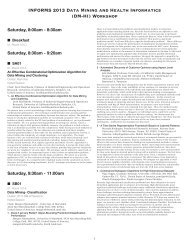
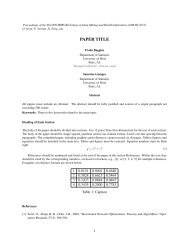
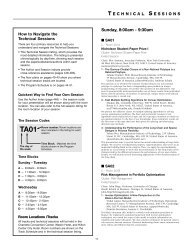
![[PDF] Charlotte Back Matter](https://img.yumpu.com/17933057/1/190x245/pdf-charlotte-back-matter.jpg?quality=85)

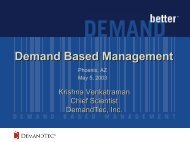
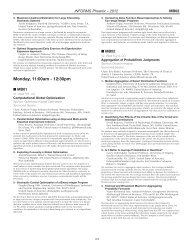
![[PDF] ALIO Back Matter](https://img.yumpu.com/17932960/1/190x245/pdf-alio-back-matter.jpg?quality=85)
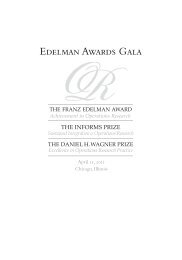
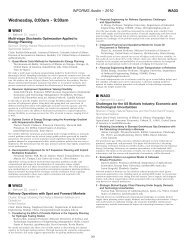
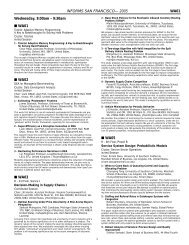
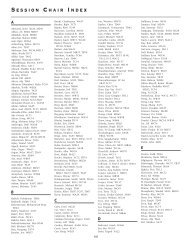
![[PDF] Monday, 8:00am - 9:30am](https://img.yumpu.com/17932954/1/190x245/pdf-monday-800am-930am.jpg?quality=85)
